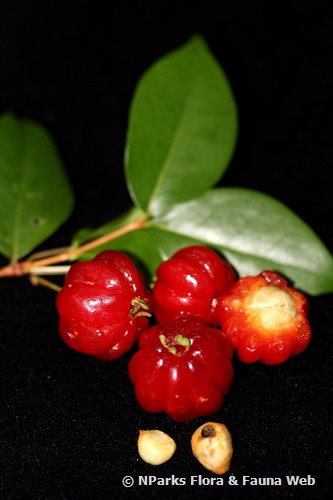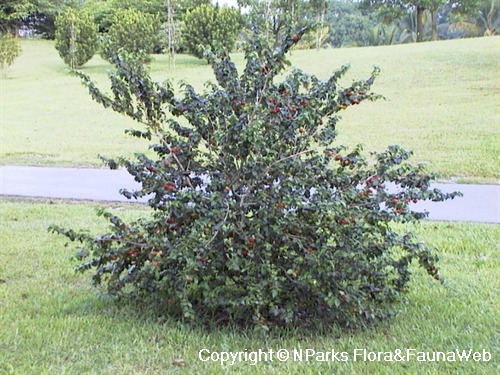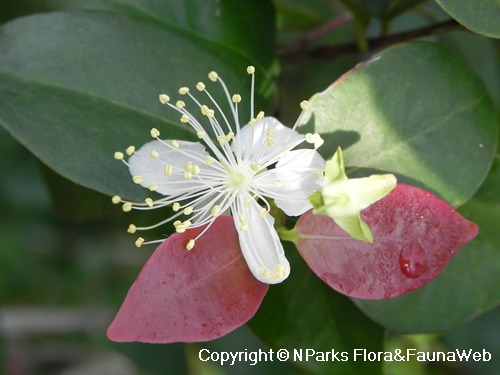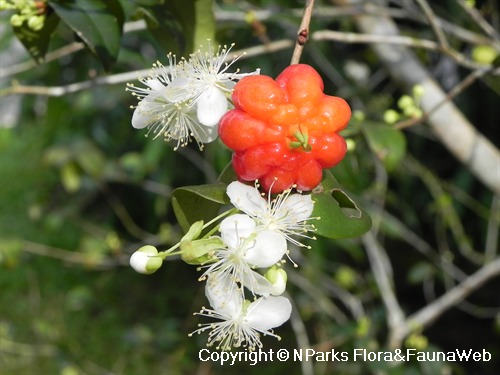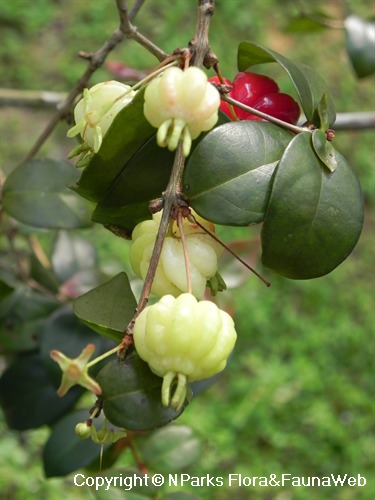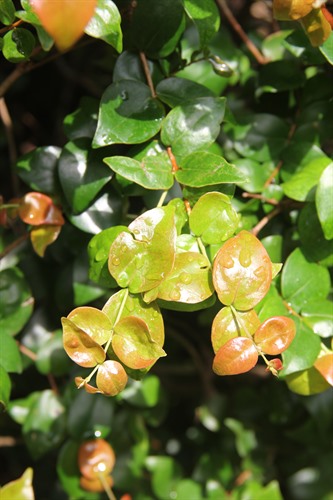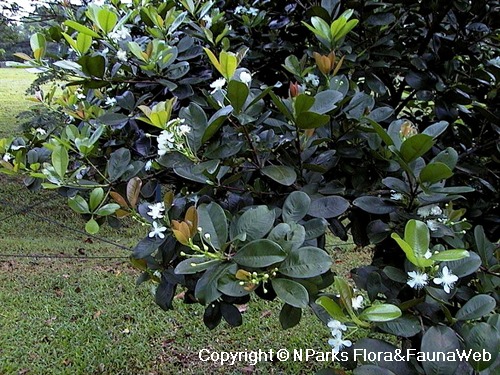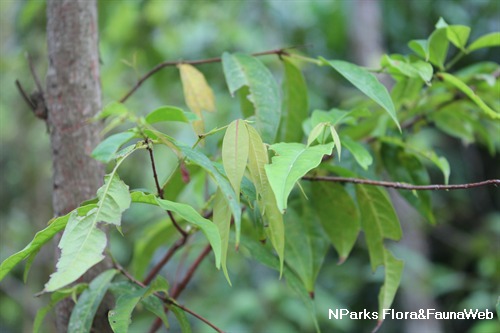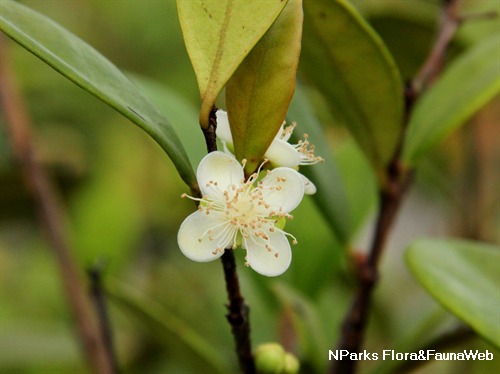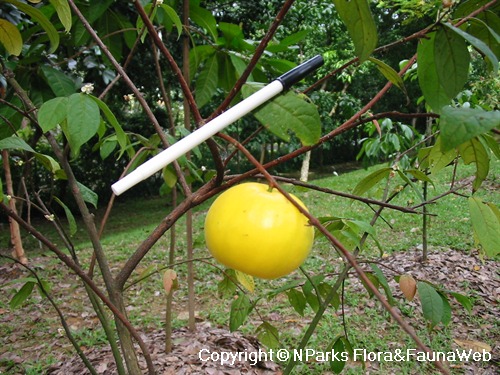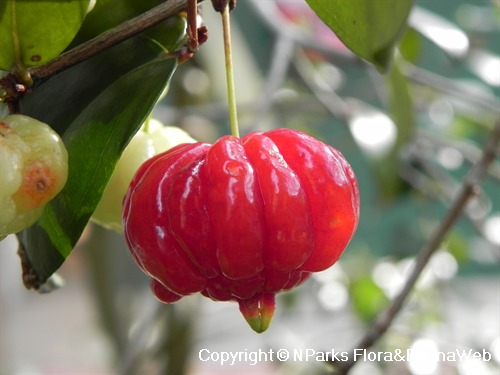
Back
Eugenia uniflora L.
| Family Name: | Myrtaceae |
| Common Name: | Surinam Cherry, Cayenne Cherry, Chermai Belanda, Red Brazil Cherry, Brazilian Cherry, 红果仔, 番樱桃 |
Name
Classifications and Characteristics
| Plant Division | Angiosperms (Flowering Seed Plants) (Dicotyledon) |
|---|---|
| Plant Growth Form | Shrub, Tree (Small (6m-15m)) |
| Lifespan (in Singapore) | Perennial |
| Mode of Nutrition | Autotrophic |
| Maximum Height | 7.5 m |
Biogeography
| Native Distribution | South America |
|---|
Description and Ethnobotany
| Growth Form | Large shrub or small tree up to 7.5 m tall. |
|---|---|
| Foliage | Dark green, papery leaves are ovate to elliptic (egg-shaped to oval) and hairless (3.2-4.2 cm long, 2.3-3 cm wide). |
| Flowers | Flowers are white and lightly fragrant. Calyx (the outermost layer of the flower) is divided into 4 oval-shaped lobes and bent backwards. Each flower has 50-60 white stamens with light yellow anthers. |
| Fruit | Bright red or maroon-purple to black fruits are shaped like miniature pumpkins with 7-8 ribs (2-4 cm wide). The juicy fruit is thin-skinned, acidic to sweet and slightly bitter. The bright red variety is more common than the darker-coloured variety. They contain either 1 round seed or 2-3 flattened seeds. |
| Cultivation | This plant grows well in most types of soil, but it prefers consistently moist soils. It begins to fruit from 2 years, but some take 5-6 years to fruit. They will produce more fruits when they are not pruned and fed with a balanced fertilizer 4 times a year. |
| Ethnobotanical Uses | Edible Plant Parts : Edible Fruits Food (Fruit or Vegetable): The fruits are edible, but the seeds are not and have caused diarrhoea in dogs. Fruits must be very ripe when picked or the taste will be resinous. |
Landscaping Features
| Desirable Plant Features | Ornamental Foliage, Ornamental Fruits |
|---|---|
| Landscape Uses | Parks & Gardens, Hedge / Screening |
Fauna, Pollination and Dispersal
| Fauna Pollination Dispersal Associated Fauna | Bird-Attracting |
|---|
Plant Care and Propagation
| Light Preference | Full Sun |
|---|---|
| Water Preference | Lots of Water |
| Plant Growth Rate | Moderate |
| Propagation Method | Seed, Air-Layering |
| Seed / Spore Germination Duration | 21 days to 28 days |
Foliar
| Mature Foliage Colour(s) | Green |
|---|---|
| Mature Foliage Texture(s) | Glossy / Shiny |
| Foliar Type | Simple / Unifoliate |
| Foliar Arrangement Along Stem | Opposite |
| Foliar Attachment to Stem | Petiolate |
| Foliar Shape(s) | Non-Palm Foliage (Ovate, Lanceolate) |
| Foliar Venation | Pinnate / Net |
| Foliar Apex - Tip | Acute, Acuminate, Obtuse |
| Foliar Base | Rounded / Obtuse |
| Leaf Area Index (LAI) for Green Plot Ratio | 4.5 (Shrub & Groundcover - Dicot) |
| Prominent Young Flush Colour(s) Remarks | Bronze |
Floral (Angiosperm)
| Flower & Plant Sexuality | Bisexual Flowers |
| Flower Colour(s) | White |
|---|
Fruit, Seed and Spore
| Mature Fruit Colour(s) | Red, Black |
|---|
Image Repository
Others
| Master ID | 701 |
|---|---|
| Species ID | 1996 |
| Flora Disclaimer | The information in this website has been compiled from reliable sources, such as reference works on medicinal plants. It is not a substitute for medical advice or treatment and NParks does not purport to provide any medical advice. Readers should always consult his/her physician before using or consuming a plant for medicinal purposes. |

